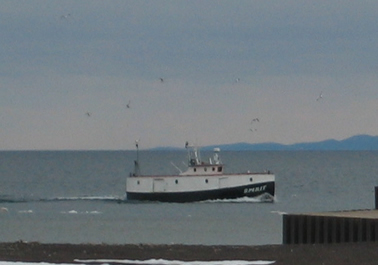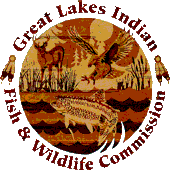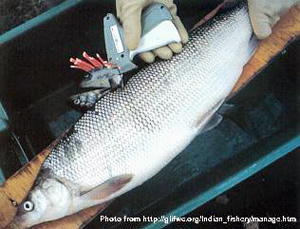Lake Superior Treaty Fishery
The Great Lakes Section works to ensure treaty reserved fishing rights are preserved by assisting its member Tribes in fishery assessments and regulation of Gichigami (Lake Superior) treaty commercial fisheries. GLIFWC member bands who fish commercially in Lake Superior include the Red Cliff andBad River Bands of Lake Superior Chippewa Indians in Wisconsin and the Keweenaw Bay and Bay Mills Indian Communities in Michigan. Large and small boat fishers are licensed through their respective tribes and must adhere to tribally adopted codes regulating the fishery.
Fish Harvest Monitoring
The Great Lakes Section focuses much of its time on chinamekos (lake trout), adikameg (whitefish), and kewis (cisco, a.k.a. lake herring), which are a culturally and nutritionally important source of low fat, high protein food which is readily found in local markets. Fish harvest monitoring occurs year-round in off-reservation fishing grounds of the 1842 Treaty ceded area within Michigan waters of Lake Superior where measuring length and weight and removing age structures from commercially harvested gigoon (fish) is a priority of the Great Lakes Section.
|
Adikameg (whitefish)
Adikameg are very important to the tribal commercial fishery which supports many jobs and provides food to the local area. The Great Lakes Section conducts assessments to identify discrete stocks, determine the distribution, track the relative abundance, and collect biological characteristics (length, weight, age) of adikameg.
Spawning concentrations of adikameg are sampled by setting gill nets at predetermined spawning locations in management units of the 1842 Treaty ceded area within Michigan waters of Gichigami. Relative abundance is tracked by calculating the number of adikameg captured per net. Stock health is tracked by measuring the length and weight and determining the age of the fish from otoliths (ear bones).
Fish captured in good physical condition are tagged with consecutively numbered orange tags and released.
|
Chinamekos (lake trout)
Lake trout are the keystone predator of Gichigami. A voracious predator and good to eat, chinamekos are sought after by the tribal commercial fishery and sport fishers alike.
Due to the vulnerability of chinamekos to bimiizii and fishing gear, biologists track the fish's abundance through sophisticated stock assessment models which explain past and predict future numbers of chinamekos in Gichigami.

The Great Lakes Section conducts fish assessments and seeks funding to carry out special projects which provide information used in the models. Spawning concentrations of chinamekos are sampled by setting gill nets at predetermined spawning locations in management units of the 1842 Treaty ceded area within Michigan waters of Gichigami.
Fish captured in good physical condition are tagged with consecutively numbered orange tags and released.
The deep water form of chinamekos, siscowet lake trout, is sampled annually in waters up to 950 feet (290 meters) deep. Trend and diet information are collected by setting bottom set gill nets over different depth strata. Biological characteristics of captured fish are measured (length, weight), otoliths (fish ear bones) are collected to determine the age of fish, and stomachs are removed to determine the diet of fish back at the lab. This deep water form is less desirable for eating but is found throughout 70% of Gichigami.
Name (lake sturgeon)
Name are identified as a culturally sensitive species under the American Indian Natural Heritage Restoration Program by the Fond du Lac, Red Cliff, and Bad River Bands of Lake Superior Chippewa, and the Keweenaw Bay and Bay Mills Indian Communities. The harvest and sharing of sturgeon is important to the culture of the Anishinaabe people.
Sturgeon continue to be harvested for ceremonial and subsistence purposes by tribal members, and are assessed by the Great Lakes Section annually in Gichigami. Relative abundance, length, weight, and girth are collected to track the health of the fish population. Sturgeon are tagged with individually numbered tags and recaptured fish provide information on movement and growth.
Completed projects funded by the Great Lakes Fish and Wildlife Restoration Act:
![]() Temperature and Depth Profiles of Namaycush (LakeTrout) in Lake Superior
Temperature and Depth Profiles of Namaycush (LakeTrout) in Lake Superior
Other projects funded by outside sources:
![]() Buffalo Reef Stamp Sands Substrate Mapping
Buffalo Reef Stamp Sands Substrate Mapping
![]() Name (Lake Sturgeon) Project on the White River in Wisconsin during 2001
Name (Lake Sturgeon) Project on the White River in Wisconsin during 2001



